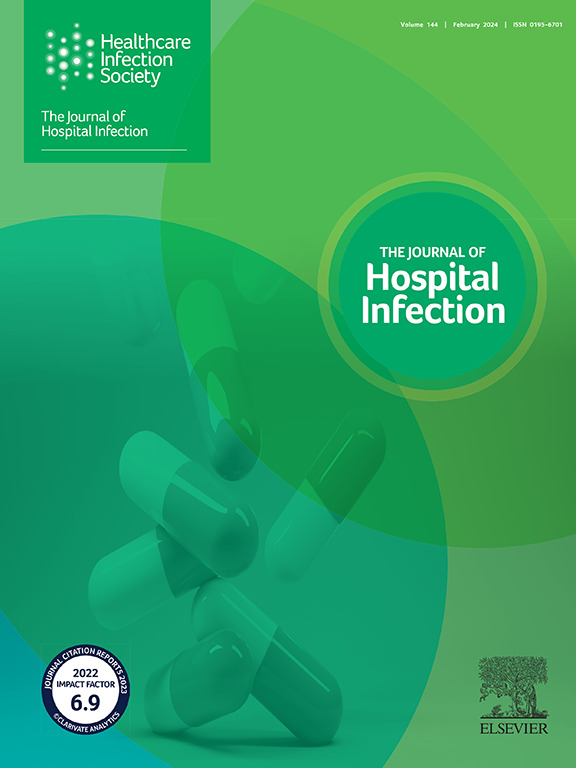Comparison of brushing efficacy for gastroscopes using different brush types under simulated contamination conditions
IF 3.1
3区 医学
Q1 INFECTIOUS DISEASES
引用次数: 0
Abstract
Background
Channel-cleaning brushes are an important tool in the reprocessing of endoscopes.
Aim
To investigate the efficacy of cleaning brushes composed of various materials in removing organic matter from the biopsy channels of flexible endoscopes.
Methods
In total, 168 cleaned gastroscopes were divided at random into six groups (A, B, C1, C2, C3 and D) based on the specific characteristics of four different types of cleaning brush. A suspension containing 12% bovine serum and 106 units of Escherichia coli was injected into the biopsy channels of each endoscope to ensure sufficient contamination. After a 5-min incubation period, brushing and sampling were performed according to the experimental protocol. The effectiveness of the cleaning process was evaluated using a protein detection test and an adenosine triphosphate test.
Results
Cleaning brushes with a metal shaft demonstrated superior performance in removing organic matter from flexible endoscopes compared with cleaning brushes with a plastic shaft (P<0.05). Similarly, brushes with bristles made of cylindrical DuPont fibres exhibited superior cleaning efficacy compared with those made of strip microfibres or caterpillar polyolefins (P<0.05). Better results were achieved when the cleaning brush was passed through the biopsy channel four times compared with once or twice (100%).
Conclusion
From the perspective of cleaning outcomes and economic benefits, the use of a cleaning brush with a metal shaft and cylindrical DuPont fibre bristles during the reprocessing of flexible endoscopes, combined with a cleaning technique involving four brush passes through the biopsy channels, can remove organic matter more effectively compared with the use of a cleaning brush made of microfibres, polyolefins and plastics.
模拟污染条件下不同刷头对胃镜的刷洗效果比较
背景:通道清洁刷是内窥镜再处理的重要工具。目的:探讨不同材料组成的清洁刷对柔性内窥镜活检通道中有机物的去除效果。方法:168例清洗过的胃镜患者,根据4种不同清洗刷的具体特点,随机分为A、B、C1、C2、C3、D 6组。将含有12%牛血清和10 μ 6单位大肠杆菌的悬浊液注射到每个内窥镜的活检通道中,以确保足够的污染。孵育5分钟后,根据实验方案进行刷毛和取样。使用蛋白质检测试验(PDT)和三磷酸腺苷试验(ATP)评估清洗过程的有效性。结果:与塑料制成的清洁刷相比,金属制成的清洁刷在清除柔性内窥镜中的有机物方面表现出更好的性能(p < 0.05)。同样,柱状杜邦纤维刷毛的清洁效果优于条状微纤维刷毛和毛虫聚烯烃刷毛(p < 0.05)。刷刷通过活检通道4次,效果优于1次或2次(100%)。结论:从清洁效果和经济效益的角度来看,在柔性内窥镜的再加工过程中,使用圆柱形杜邦纤维刷毛和金属轴清洁刷,结合四次刷过活检通道的清洁技术,可以更有效地去除有机物。
本文章由计算机程序翻译,如有差异,请以英文原文为准。
求助全文
约1分钟内获得全文
求助全文
来源期刊

Journal of Hospital Infection
医学-传染病学
CiteScore
12.70
自引率
5.80%
发文量
271
审稿时长
19 days
期刊介绍:
The Journal of Hospital Infection is the editorially independent scientific publication of the Healthcare Infection Society. The aim of the Journal is to publish high quality research and information relating to infection prevention and control that is relevant to an international audience.
The Journal welcomes submissions that relate to all aspects of infection prevention and control in healthcare settings. This includes submissions that:
provide new insight into the epidemiology, surveillance, or prevention and control of healthcare-associated infections and antimicrobial resistance in healthcare settings;
provide new insight into cleaning, disinfection and decontamination;
provide new insight into the design of healthcare premises;
describe novel aspects of outbreaks of infection;
throw light on techniques for effective antimicrobial stewardship;
describe novel techniques (laboratory-based or point of care) for the detection of infection or antimicrobial resistance in the healthcare setting, particularly if these can be used to facilitate infection prevention and control;
improve understanding of the motivations of safe healthcare behaviour, or describe techniques for achieving behavioural and cultural change;
improve understanding of the use of IT systems in infection surveillance and prevention and control.
 求助内容:
求助内容: 应助结果提醒方式:
应助结果提醒方式:


